必修3Module6 non-defining attributive clauses非限制性定语从句全英文说课稿
- 格式:doc
- 大小:50.00 KB
- 文档页数:3
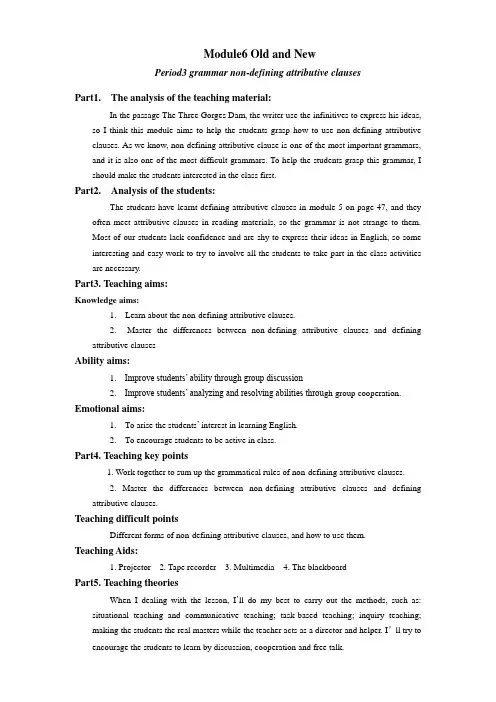
Module6 Old and NewPeriod3 grammar non-defining attributive clausesPart1. The analysis of the teaching material:In the passage The Three Gorges Dam, the writer use the infinitives to express his ideas, so I think this module aims to help the students grasp how to use non-defining attributive clauses. As we know, non-defining attributive clause is one of the most important grammars, and it is also one of the most difficult grammars. To help the students grasp this grammar, I should make the students interested in the class first.Part2. Analysis of the students:The students have learnt defining attributive clauses in module 5 on page 47, and they often meet attributive clauses in reading materials, so the grammar is not strange to them.Most of our students lack confidence and are shy to express their ideas in English, so some interesting and easy work to try to involve all the students to take part in the class activities are necessary.Part3. Teaching aims:Knowledge aims:1. Learn about the non-defining attributive clauses.2. Master the differences between non-defining attributive clauses and definingattributive clausesAbility aims:1.Improve students’ ability through group discussion2.Improve students’ analyzing and resolving abilities throu gh group cooperation. Emotional aims:1. To arise the students’ interest in learning English.2. To encourage students to be active in class.Part4. Teaching key points1. Work together to sum up the grammatical rules of non-defining attributive clauses.2. Master the differences between non-defining attributive clauses and definingattributive clauses.Teaching difficult pointsDifferent forms of non-defining attributive clauses, and how to use them.Teaching Aids:1. Projector2. Tape recorder3. Multimedia4. The blackboardPart5. Teaching theoriesWhen I dealing with the lesson, I’ll do my best to carry out the methods, such as: situational teaching and communicative teaching; task-based teaching; inquiry teaching;making the students the real masters while the teacher acts as a director and helper. I’ll try to encourage the students to learn by discussion, cooperation and free talk.In addition, I’ll make the best of multimedia to make the class more lovely, interesting and high-effective.Part6. Teaching Procedures 45’Step1 Lead in 12’1. Lead in the lesson of the unit by showing some sentences which they learnt on page47 about defining attributive clauses on screen. Ask students read the sentences and answerwhat clauses they are.(1) Su Song was an eleventh-century monk who(m) very little is known about.(2) For example, it is the country which silk was first invented in.2 review the relative pronouns and relative adverbs which usually used in attributiveclauses.(1) Relative pronounsas,which,who,whom,whose, that(2) Relative adverbswhen, where, why(Purpose: review defining attributive clauses which students learnt on module 5.)3. Ask students read above sentences and do exercise1’s sentences on page 54, thencheck the answer and find out the common and the difference of these sentences.(Purpose: lead in the topic: non-defining attributive clauses.)Step2 Non-defining attributive clauses 20’1.Encourage the students to sum up the differences between non-defining attributiveclauses and defining attributive clauses by themselvesIn a defining attributive clause(1) The information given is essential to understand the sentence, and make it clearwhich person or thing you are talking about in a sentence.(2) You don’t need a commaIn a non-defining attributive clauses(1) The information is not essential to understand the sentence, but it provides additionalinformation.(2) Punctuation is important, common are used to separate the clause from the rest of thesentence.(3) ‘That’ canno t be used in a non-defining attributive clause.2. The definition of non-defining attributive clause.When a attributive clause merely describes an object without having the function of defining or identifying to which object the speaker or writer is referring, the clause must be placed between commas. Such a clause can be called a non-defining or non-limiting relative clause, i.e., a non-defining relative clause gives extra information about a noun or noun phrase and has commas at both ends.(Purpose: this part is designed to make the students understand the definition of non-defining attributive clauses and the difference between non-defining attributive clausesand defining attributive clauses, at the same time lead to the next part.)Step3 Practice 8’Get the students to finish excercise2 and 3 on page 54, and then check the answer. I’ll divide the students into 2 groups, and then ask them to finish the tasks by competition and cooperation. If anyone answers the question correctly, his or her group will get 1 point, and the group which gets the most points is the winner.(Purpose: To consolidate the usage of non-defining attributive clauses, at the same time increase the students ‘interest in their studies)Step4 Summary 4’First, ask the students to d iscuss “What have you learnt this class?”Then give the summary: This class we learn the grammatical items of non-defining attributive clauses. We know the differences between non-defining attributive clauses and defining attributive clauses are common and the information given is essential or not essential to understand the sentence.Step 5Homework 1’Revise the use of non-defining attributive clauses.Part 7 Blackboard designNon-defining attributive clauses(1) Relative pronouns : as,which,who,whom,whose, that(2) Relative adverbs: when, where, whyNon-defining attributive clauses(1) The information is not essential to understand the sentence, but it provides additional information.(2) Punctuation is important, common are used to separate the clause from the rest of the sentence.(3) ‘That’ cannot be used in a non-defining attributive clause.(Purpose: the blackboard design can reflect the teacher’s ability of mastering the text and leading the students to master the text easily. It also tells the students that this is the important points in this class.)Above is my teaching plan of this lesson. Thank you for listening.。
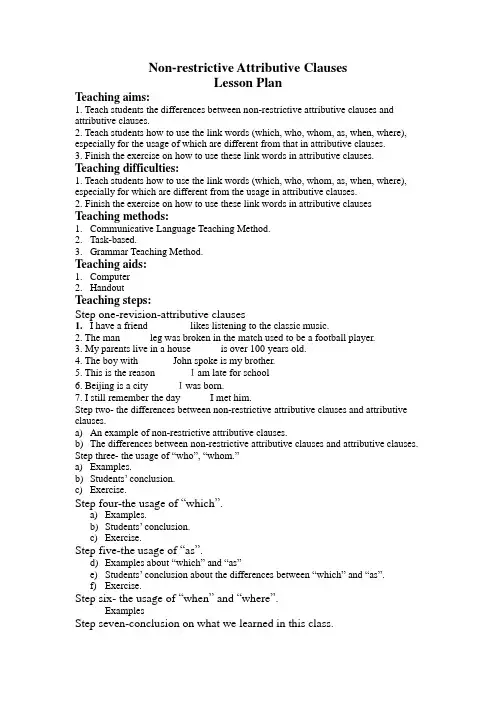
Non-restrictive Attributive ClausesLesson PlanTeaching aims:1. Teach students the differences between non-restrictive attributive clauses and attributive clauses.2. Teach students how to use the link words (which, who, whom, as, when, where), especially for the usage of which are different from that in attributive clauses.3. Finish the exercise on how to use these link words in attributive clauses. Teaching difficulties:1. Teach students how to use the link words (which, who, whom, as, when, where), especially for which are different from the usage in attributive clauses.2. Finish the exercise on how to use these link words in attributive clauses Teaching methods:municative Language Teaching Method.2.Task-based.3.Grammar Teaching Method.Teaching aids:puter2.HandoutTeaching steps:Step one-revision-attributive clauses1.I have a friend________ likes listening to the classic music.2. The man _____ leg was broken in the match used to be a football player.3. My parents live in a house _____ is over 100 years old.4. The boy with ______ John spoke is my brother.5. This is the reason ______Iam late for school6. Beijing is a city _____Iwas born.7. I still remember the day _____ I met him.Step two- the differences between non-restrictive attributive clauses and attributive clauses.a)An example of non-restrictive attributive clauses.b)The differences between non-restrictive attributive clauses and attributive clauses. Step three- the usage of “who”, “whom.”a)Examples.b)Students’ conclusion.c)Exercise.Step four-the usage of “which”.a)Examples.b)Students’ conclusion.c)Exercise.Step five-the usage of “as”.d)Examples about “which” and “as”e)Students’ conclusion about the differences between “which” and “as”.f)Exercise.Step six- the usage of “when” and “where”.ExamplesStep seven-conclusion on what we learned in this class.1. 在非限制性定语从句中,先行词为人时关系词只能用______做主语,用______ 做宾语。
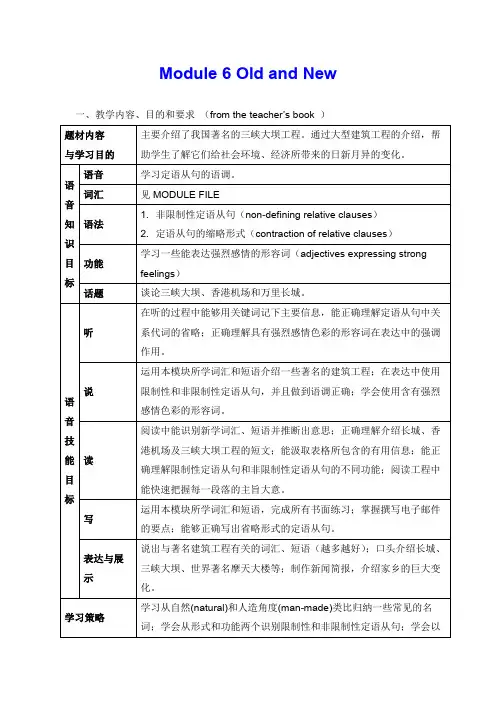
Module 6 Old and New 一、教学内容、目的和要求(from the teacher’s book )Period 1Introduction + Listening + PronunciationPart 1. IntroductionTask: Practice oral expression by learning man-made projects.Teaching procedures:1. 1) Discuss the four questions in pairs.2) Ask the students to read out their answers.2. 1) Read through the words in the box and ask the students to look up the words they don’t know.2) Play a game. The teacher says some explanations of the words and let the students say this word out.3. 1) Before reading the passage, ask: How much do you know about the Great Wall of China /Hongkong International Airport /The Three Gorges Dam?2) Let the students read through the passage and write down the key words.3) Work in groups to introduce the one of the three man-made projects4) Find the answers to the three questions on the student’s book.4. Explain some new words, phrases.Part 2. ListeningTask:Train the students to make notes while listening and pay attention to the language phenomena to make preparations for Function and Everyday English.Teaching procedures:1. 1) Ask the students to read the subjects2) Listen to the tape and tick the subjects that they hear3) Check the answers with them2. 1) Read through the questions.2) Listen to the tape again and answer the questions.3) Check their answers.3. 1) Have the students do the activity individually, then check with a partner. 2) Listen to the tape once more to check their answers.Part 3. PronunciationTask:Practise the intonation of the students with non-defining attributive clauses.Teaching procedures:1. Read the sentences and underline the attributive clauses.2. Check their answers.3. Play the type for a couple of times.4. Let the students follow the tape to read.5. Pair them to practice.Homework: Write about a famous man-made project..Period 2 Reading and VocabularyTask: Learn about the Three Gorges Dam.Teaching procedures:1. Revision Ask the students to introduce another man-made project2. 1) Deal with the new words and phrases in the text by reading for them.2) Make sure the students know about their meanings.3. Ask the students to do “T” or “F” questions and check the answers.4. 1) Have the students read the questions and then read the text.2) Ask the students to answer the questions one by one and correct them.5.1) Ask the students to read the passage again.2) Write questions for the answers.6. Give the students some other questions to answer.7. 1) Read the text again and write down the key words.2) Try to say something about the Three Gorges Dam without referring to the book.8.1) Work in groups to discuss the questions on the student’s book.2) Call back their ideas.Home work: Retell the passage about the Three Gorges Dam.Period 3 Language points of Reading +Task +speaking Part 1. Language points of ReadingTeaching procedures:1. Revision Let students retell the text.2. Key words, phrases1) dream vt. +n./prep./that clauseeg. He dreamt that he was flying around the earth .I dreamt a sweet dream last night.dream of 梦见,向往,渴望eg. Tom often dreams of having his own car.2) hold back阻止,阻碍eg. Nothing can hold back the wheel of history.……忍住,抑制eg. Hearing the exciting news. She couldn’t hold back her tears.隐瞒,保留eg. He held something back from me.3) provide something for sb./sb. with sth. 为某人提供某物eg. Our school provided books for us.= Our school provided us with books.4) 建议suggest sth./sth. to sb. /doing sth. /that-clauseeg. The teacher suggested a rest to us.He suggested starting at once.The doctor suggested the patient ( should ) be operated on immediately.表明,暗示。

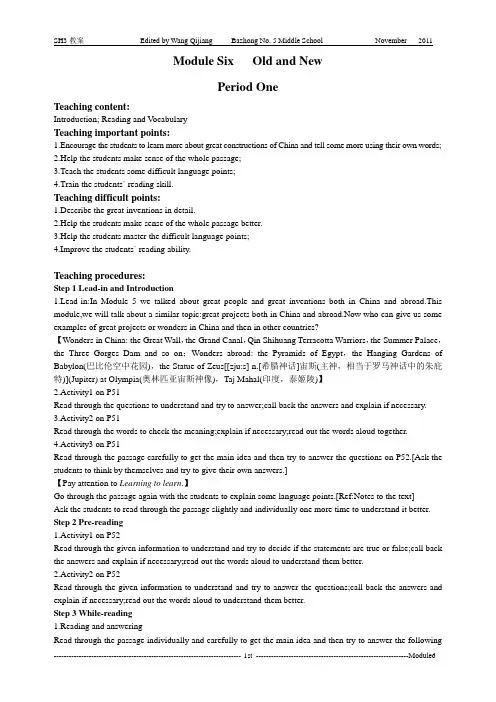
Module Six Old and NewPeriod OneTeaching content:Introduction; Reading and V ocabularyTeaching important points:1.Encourage the students to learn more about great constructions of China and tell some more using their own words;2.Help the students make sense of the whole passage;3.Teach the students some difficult language points;4.Train the students` reading skill.Teaching difficult points:1.Describe the great inventions in detail.2.Help the students make sense of the whole passage better.3.Help the students master the difficult language points;4.Improve the students` reading ability.Teaching procedures:Step 1 Lead-in and Introduction1.Lead-in:In Module 5 we talked about great people and great inventions both in China and abroad.This module,we will talk about a similar topic:great projects both in China and abroad.Now who can give us some examples of great projects or wonders in China and then in other countries?【Wonders in China: the Great Wall,the Grand Canal,Qin Shihuang Terracotta Warriors,the Summer Palace,the Three Gorges Dam and so on;Wonders abroad: the Pyramids of Egypt,the Hanging Gardens of Babylon(巴比伦空中花园),the Statue of Zeus[[zju:s] n.[希腊神话]宙斯(主神,相当于罗马神话中的朱庇特)](Jupiter) at Olympia(奥林匹亚宙斯神像),Taj Mahal(印度,泰姬陵)】2.Activity1 on P51Read through the questions to understand and try to answer;call back the answers and explain if necessary.3.Activity2 on P51Read through the words to check the meaning;explain if necessary;read out the words aloud together.4.Activity3 on P51Read through the passage carefully to get the main idea and then try to answer the questions on P52.[Ask the students to think by themselves and try to give their own answers.]【Pay attention to Learning to learn.】Go through the passage again with the students to explain some language points.[Ref:Notes to the text]Ask the students to read through the passage slightly and individually one more time to understand it better. Step 2 Pre-reading1.Activity1 on P52Read through the given information to understand and try to decide if the statements are true or false;call back the answers and explain if necessary;read out the words aloud to understand them better.2.Activity2 on P52Read through the given information to understand and try to answer the questions;call back the answers and explain if necessary;read out the words aloud to understand them better.Step 3 While-reading1.Reading and answeringRead through the passage individually and carefully to get the main idea and then try to answer the followingquestions:[These questions are to be chosen and other material can be used too.]Questions:1)What is the dream of Mao Zedong?2)Why was the Three Gorges Dam built?3)What is the size of the Three Gorges Dam?4)What is the advantage of the Three Gorges Dam?5)What happened after the reservoir was built?6)How are people who lived in the region?7)What has happened to the historical sites?8)What is done to protect and save the relics?Suggested answers:1)“Walls of stone to hold back clouds and rain till a smooth lake rises in the narrow gorges.”2)To control flooding and provide hydro-electric power.3)The dam is nearly 200 meters high and 1.5 kilometers wide.4)To generate heat and electricity and prevent air pollution and help reduce the global warming.5)The reservoir has flooded 2 cities, 11 cities, 140 towns and more than 4000 villages.6)They are living a happy new life in different areas.7)Many historical relics and historical sites were flooded and have been submerged.8)Some of them are being removed and some are being put into museum.2.ExplanationGo through the passage with the students to explain some difficult language points.[Ref: Notes to the text]3.ConsolidationAsk the students to read through the passage quietly and individually one more time to understand it better.Time permitting, listen to the tape and follow it.Step 4 Post-reading1.Activity3 on P53Scan the passage to write questions for the answers;call back the answers and explain if necessary;read through the completed questions and answers individually and quietly to understand them better.*2.Activity4 on P54[*This part can be omitted for our students,but ask them to read through the questions to understand the requirement.Ask the students to think by themselves and help them form a right attitude to things.Everything is a two-side sword.Everything has its advantages and disadvantages.We should treat and make use of it scientifically.]Step 5 Summary and Homework1.Summary: Summarize what they have learned in this period.2.Homework: Reading on P99-100 in workbook.Appendix: Notes to the text1.Try to work out what kind of word it is.▲work out “解决,找到…的答案;算出,计算;理解,弄懂”e.g:to work out a problem 解决问题It's not easy to work out how much it costs to feed the average family.算出一个一般家庭的花费并非易事。
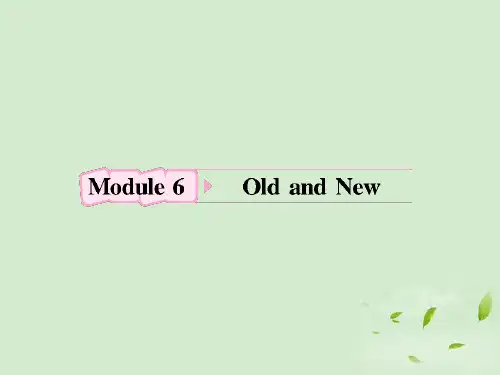
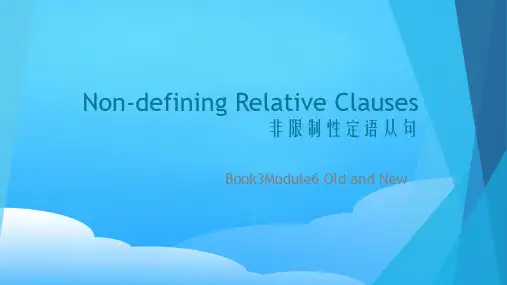
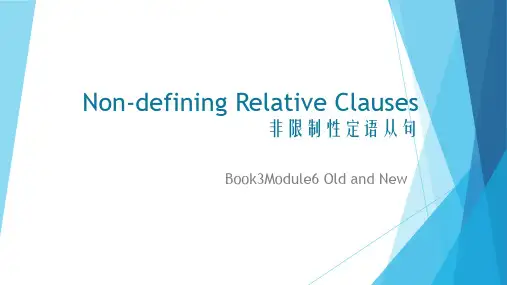


Teaching plan for Module 6 Book3 --Grammar: Non-defining attributive clauses------------Zhao Min Good morning, everyone, it’s my great pleasure to be here sharing my lessons with you. The content of the lesson is Non-defining attributive clauses. I’ll begin the lesson from the following five parts, the teaching material, the teaching methods, the studying methods, the teaching procedure and blackboard design. First, Ok now I am going to start from the first part.Firstly,let me introduce the teaching material.In the passage- old and new, the writer uses Non-defining attributive clauses to express his ideas, so I think this module aims to help the students grasp how to use Non-defining attributive clauses. As we know, Non-defining attributive clauses is one of the most important grammars, and it is also one of the most difficult grammars.Secondly, I want to tell something about the students.The students have learnt something about defining attributive clauses in Junior High school, and they often meet defining attributive clauses in reading materials, so I think the grammar is not strange to them. To help the students grasp Non-defining attributive clauses, I should make the students interested in the class first. So I use a story to heat the classroom atmosphere. Most of our students are from rural middle school, so they lack confidence and are shy to express their ideas in English, so I design some interesting and easy work to try to involve all the students in taking part in the class activities, so that all of them can achieve some success in class. Meanwhile, I lay particular emphasis on developing students’ interest in English and provide the students with a good environment, relaxing atmosphere and more chances for individual and group practice.Thirdly, I’d like to talk about teaching aims and demandsIt is requested in the New Standard English that we should improve the students’ integrating skills of listening, speaking, reading and writing, so I set some activities to develop the students’ integrating skills and the ability of imagination and creativity. According to these, I set my teaching aims as follows:1 Knowledge aims:A. Make the students learn to sum up grammatical rules by themselvesB. Make sure the students master the grammatical items2 Ability aims: A. listening: get information from the listening materialsB. Speaking: express one’s ideas in EnglishC. Reading: sum up grammatical rules by themselvesD. Writing: make up a whole story using Non-defining attributive clauses3 Emotional aims: A. To arise the students’ interest in learning EnglishB. To encourage students to be active in classFourthly, teaching important points is1. Work together to sum up the grammatical rules of Non-defining attributive clauses2. Encourage students to think in the English wayTeaching difficult points isstudents can use and understand Non-defining Attributive Clauses correctly.Teaching Aids:pictures; tape-recorder; multi-mediaPart 2 Teaching MethodsAccording to the analysis above, I’ll try to use the following theories to make students the real master of the class while the teacher acts as a director and helper.a. Communicative Language TeachingLanguage is used for communication. It’s learner-centered and it’s very important to emphasize communication in English. I’ll create some real-life situations, have students “free talk”,express their ideas with their own words. It can improve students’ spoken English ability.b. Task-based Language TeachingGive students some specific tasks around the teaching material, make them know what they need to do ,which problems they need to deal with in class. Let students join the activities and finish the tasks by pair work or individuals.The aim is to develop students’ability to deal with the problem and help them have a better understanding of the teaching materials.c. Computer Assisted Language TeachingThe Computer Assisted Language Teaching can provide students attractive materials, creating vivid language learning environment. It can shorten the time for students to understand, improve the quality of teaching. In addition, I’ll make the best of multi-media and slides to make the class more lovely, interesting and high-effective.Part 3 studying MethodsStudents can take the following learning methods: task-based, self-dependent and cooperative learning. Part 4 Teaching ProcedureStep 1 Revision (2`)1.1. Review defining Attributive Clauses.(purpose: to review defining Attributive Clauses , because the it will be used in the later activity)Step2 . Leading in (3`)T:Hello, everyone.Today we will learn a new grammar together .Now I will give you some sentences .I hope you can gather two of them to one sentence."Lily is a girl .She is 16-year-old.She is a high school student.She has four families--Father ,mother,little sister and herself.And her sister is a high school student too."Ss:...T:Ok ,it seems a little difficult for you .So I will do it for you.Like: Lily ,who is 16-year-old,is a high school student.Step3. Grammer (25`)T:In this sentence ,we can see, the words follow "who"can use to explain and discreb Lily.And the form like this sentence we can call it Non-defining Attributive Clauses.Its definition is"非限定性定语从句起补充说明作用,缺少也不会影响全句的理解,在非限定性定语从句的前面往往有逗号隔开,如若将非限定性定语从句放在句子中间,起前后都需要用逗号隔开。
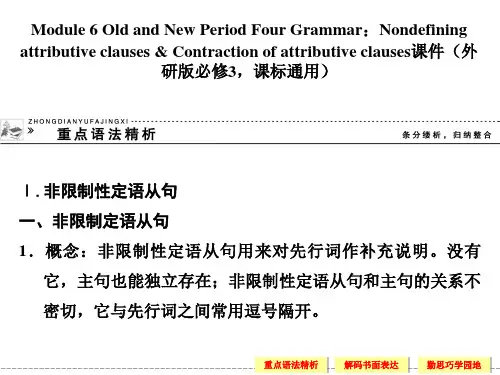
Module 6 Non-defining attributive clauses一.教学分析1.教学内容分析本课教学材料为外国语教育与研究高中英语教材第三本书Module 6 Grammar 非限制性定语从句。
学生分析本节课的教学对象是高一年级的11班。
该班级的学生学习态度认真,但存在分层且学生基础较弱。
在之前学习了限制性定语从句,对定语从句有一定的了解。
教学目标在本节课结束后,学生能够:(1)了解定语从句的概念。
(2)掌握定语从句的连词和用法。
(3)能够区分限制性定语从句和非限制性定语从句。
2.教学设计思路本节课的教学设计旨在让学生进一步的熟悉定语从句,进而区分限制性定语从句和非限制性定语从句。
3.教学过程(1)引入通过猜一猜的游戏,让学生感知定语从句,并且有意识的让学生感知限制性定语从句He is a man.He is a successful businessman.He is a successful businessman, who is founder and cheif executive officer(CEO) ofHuawei.It is a telephone.It is the latest telephone.It gains much populartiy.The latest telephone, which is produced by Huawei company, gains much popularity.It is a food.It is a traditional Chinese food.It is a traditional Chinese food, which is made of rice wrapped by bamboo leaves.He is a man.He is a great poet.He is a great poet, who threw himself into Mi Low Rive to show his patriotism(爱国主义).(2)感知非限制性定语从句,并进行情感渗透。
Period 2 Grammar—Non-defining relative clauses■Goals●To learn about non-defining clauses and contraction of relative clauses■Procedures1.My sister, who is studying German, wants to travel to Switzerland.2.The girl(who, whom, that) you saw at the meeting is a well-known swimmer.3.Mr. Henry, whom we will meet tomorrow, will be our guide.4.His uncle, to whom we send a birthday card every year, is ninety-one years old.5.Is that the student to whom you lent your dictionary?6.Wang Hong has a cat which follows her everywhere.7.The package that arrived last night is on the table.8.The TV set in the corner, which is covered in books, is mine.9.He lives in Boston, which is only half an hours ride from here.10.My cousin, whose family lives in Europe, will visit us for a few weeks.11.He is the very worker whose picture we saw in the newspaper yesterday.12.The tree, the branches of which overhung the street, was covered with blossoms.高考链接1. New York, ____ last year, is a nice old city. (2003北京)A. that I visitedB. which I visitedC. where I visitedD. in which I visited2. ---It’s thirty years since we last met. (2006四川)---But I still remember the story, believe it or not, ___ we got lost on a rainy night.A. whichB. thatC. whatD. none3. I have many friends, some are businessmen.(2005 山西)A.of them B.from which C.who of D.of whom4. Jim passed the driving test, _________ surprised everybody in the office. (2005浙江)A. whichB. hatC. thisD. it5. The place ______ the bridge is supposed to be built should be________the cross-rivertraffic is the heaviest. (2005江苏)A. which; whereB. at which; whichC. at which; whereD. which; in which答案:1-5 BBDACStep 3: Practicing non-defining relative clauses1. There is a hotel doctor on call, _____A. who will provide emergency medical treatment.B. where you can sweat out the dirt from the city.C. where you can get your hair done.D. where you can keep fit.2. There is a team of highly qualified secretaries available, _____A. where you can unwind over a few drinks.B. where you can sweat out the dirt from the city.C.where you can keep fit.D. who will help you with your paperwork.3. There is 24 hour room service, _____A.who provides a manicure(修指甲) service in your room.B. which will take you to and from the airport.C.which provides an excellent selection of snacks and drinks.D.where you can send and receive faxes.4. There is a typical English pub, _____A.where you can get seats for all the hit shows.B. who provides a manicure service inyour room.C. which will take you to and from the airport.D. where you can enjoy a pint of bitter.5. There is a gymnasium in the basement, _____A.where you can unwind over a few drinks.B. where you can sweat out the dirt from thecity.C. where you can keep fit.D. where you can buy goods at duty free prices.6. There is a qualified chiropodist(手足病医生) available, _____A.where you can get seats for all the hit shows.B. who provides a manicure servicein your room.C. where you can relax over a gourmet meal.D. which will clean your clothes overnight.7. We have a ticket reservation(预定) service, _____A.where you can get seats for all the hit shows.B. where you can relax over a gourmetmeal.C. which will clean your clothes overnight.D. where you can send and receive faxes.8. There is a top class hairdressing salon on the ground floor, _____A.where you can sweat out the dirt from the city.B. where you can get your hair done.C. which stays open until 4.00 a.m.D. where you can buy goods at duty free prices.9. There is a typical English fish and chip restaurant, _____A.where you can have cod(鳕) and chips.B. which will take you to and from the airportC. which provides an excellent selection of snacks and drinks.D. where you can enjoy a pint of bitter.10. If you have a problem, contact the senior receptionist, _____A.where you can have cod and chips.B. who will deal with it as a top priority.C. which will take you to and from the airportD. where you can enjoy a pint of bitter.11. There is a fax machine at the front desk, _____A.where you can unwind over a few drinks.B.who will look after your small children whilst you go shopping.C.where you can relax over a gourmet meal.D.where you can send and receive faxes.12. There is a dry-cleaning service available, _____A.where you can unwind over a few drinks.B. where you can relax over a gourmet meal.C. which will clean your clothes overnight.D. who will help you with your paperwork.13. Be sure to speak to our tourist guide, _____A.who will deal with it as a top priority.B. who will tell you about interesting placesto visit.C. which provides an excellent selection of snacks and drinks.D. where you can enjoy a pint of bitter.14. There is a sauna(桑拿浴) in the hotel, _____A.where you can unwind over a few drinks.B. where you can sweat out the dirt from thecity.C. which stays open until 4.00 a.m.D. where you can buy goods at duty free prices.15. There is a night club in the hotel, _____A.where you can unwind over a few drinks.B. who will deal with it as a top priority.C. which stays open until 4.00 a.m.D. where you can buy goods at duty free prices.16. There is a five-star restaurant, _____A.where you can unwind over a few drinks.B. where you can relax over a gourmet meal.C. where you can keep fit.D. who will help you with your paperwork.17. There is a trained nursery nurse available, _____A.where you can unwind over a few drinks.B.who will look after your small children whilst you go shopping.C.where you can get your hair done.D. who will help you with your paperwork.18. There is a shuttle bus service, _____A.where you can get seats for all the hit shows.B. which will take you to and fromthe airport.C. which will clean your clothes overnight.D. where you can send and receive faxes.19. For a late drink, come to our night-club, _____A.where you can have cod and chips.B. who will deal with it as a top priority.C. which stays open until 4.00 a.m.D. where you can enjoy a pint of bitter.20. For that perfect gift, come to our gift shop, _____A.where you can have cod and chips.B. who will tell you about interesting places tovisit.高考链接定语从句是高中英语学习的重要语法项目之一,也是历年高考的热点。
Module6 Old and NewPeriod3 grammar non-defining attributive clausesPart1. The analysis of the teaching material:In the passage The Three Gorges Dam, the writer use the infinitives to express his ideas, so I think this module aims to help the students grasp how to use non-defining attributive clauses. As we know, non-defining attributive clause is one of the most important grammars, and it is also one of the most difficult grammars. To help the students grasp this grammar, I should make the students interested in the class first.Part2. Analysis of the students:The students have learnt defining attributive clauses in module 5 on page 47, and they often meet attributive clauses in reading materials, so the grammar is not strange to them.Most of our students lack confidence and are shy to express their ideas in English, so some interesting and easy work to try to involve all the students to take part in the class activities are necessary.Part3. Teaching aims:Knowledge aims:1. Learn about the non-defining attributive clauses.2. Master the differences between non-defining attributive clauses and definingattributive clausesAbility aims:1.Improve students’ ability through group discussion2.Improve students’ analyzing and resolving abilities throu gh group cooperation. Emotional aims:1. To arise the students’ interest in learning English.2. To encourage students to be active in class.Part4. Teaching key points1. Work together to sum up the grammatical rules of non-defining attributive clauses.2. Master the differences between non-defining attributive clauses and definingattributive clauses.Teaching difficult pointsDifferent forms of non-defining attributive clauses, and how to use them.Teaching Aids:1. Projector2. Tape recorder3. Multimedia4. The blackboardPart5. Teaching theoriesWhen I dealing with the lesson, I’ll do my best to carry out the methods, such as: situational teaching and communicative teaching; task-based teaching; inquiry teaching;making the students the real masters while the teacher acts as a director and helper. I’ll try to encourage the students to learn by discussion, cooperation and free talk.In addition, I’ll make the best of multimedia to make the class more lovely, interesting and high-effective.Part6. Teaching Procedures 45’Step1 Lead in 12’1. Lead in the lesson of the unit by showing some sentences which they learnt on page47 about defining attributive clauses on screen. Ask students read the sentences and answerwhat clauses they are.(1) Su Song was an eleventh-century monk who(m) very little is known about.(2) For example, it is the country which silk was first invented in.2 review the relative pronouns and relative adverbs which usually used in attributiveclauses.(1) Relative pronounsas,which,who,whom,whose, that(2) Relative adverbswhen, where, why(Purpose: review defining attributive clauses which students learnt on module 5.)3. Ask students read above sentences and do exercise1’s sentences on page 54, thencheck the answer and find out the common and the difference of these sentences.(Purpose: lead in the topic: non-defining attributive clauses.)Step2 Non-defining attributive clauses 20’1.Encourage the students to sum up the differences between non-defining attributiveclauses and defining attributive clauses by themselvesIn a defining attributive clause(1) The information given is essential to understand the sentence, and make it clearwhich person or thing you are talking about in a sentence.(2) You don’t need a commaIn a non-defining attributive clauses(1) The information is not essential to understand the sentence, but it provides additionalinformation.(2) Punctuation is important, common are used to separate the clause from the rest of thesentence.(3) ‘That’ canno t be used in a non-defining attributive clause.2. The definition of non-defining attributive clause.When a attributive clause merely describes an object without having the function of defining or identifying to which object the speaker or writer is referring, the clause must be placed between commas. Such a clause can be called a non-defining or non-limiting relative clause, i.e., a non-defining relative clause gives extra information about a noun or noun phrase and has commas at both ends.(Purpose: this part is designed to make the students understand the definition of non-defining attributive clauses and the difference between non-defining attributive clausesand defining attributive clauses, at the same time lead to the next part.)Step3 Practice 8’Get the students to finish excercise2 and 3 on page 54, and then check the answer. I’ll divide the students into 2 groups, and then ask them to finish the tasks by competition and cooperation. If anyone answers the question correctly, his or her group will get 1 point, and the group which gets the most points is the winner.(Purpose: To consolidate the usage of non-defining attributive clauses, at the same time increase the students ‘interest in their studies)Step4 Summary 4’First, ask the students to d iscuss “What have you learnt this class?”Then give the summary: This class we learn the grammatical items of non-defining attributive clauses. We know the differences between non-defining attributive clauses and defining attributive clauses are common and the information given is essential or not essential to understand the sentence.Step 5Homework 1’Revise the use of non-defining attributive clauses.Part 7 Blackboard designNon-defining attributive clauses(1) Relative pronouns : as,which,who,whom,whose, that(2) Relative adverbs: when, where, whyNon-defining attributive clauses(1) The information is not essential to understand the sentence, but it provides additional information.(2) Punctuation is important, common are used to separate the clause from the rest of the sentence.(3) ‘That’ cannot be used in a non-defining attributive clause.(Purpose: the blackboard design can reflect the teacher’s ability of mastering the text and leading the students to master the text easily. It also tells the students that this is the important points in this class.)Above is my teaching plan of this lesson. Thank you for listening.。